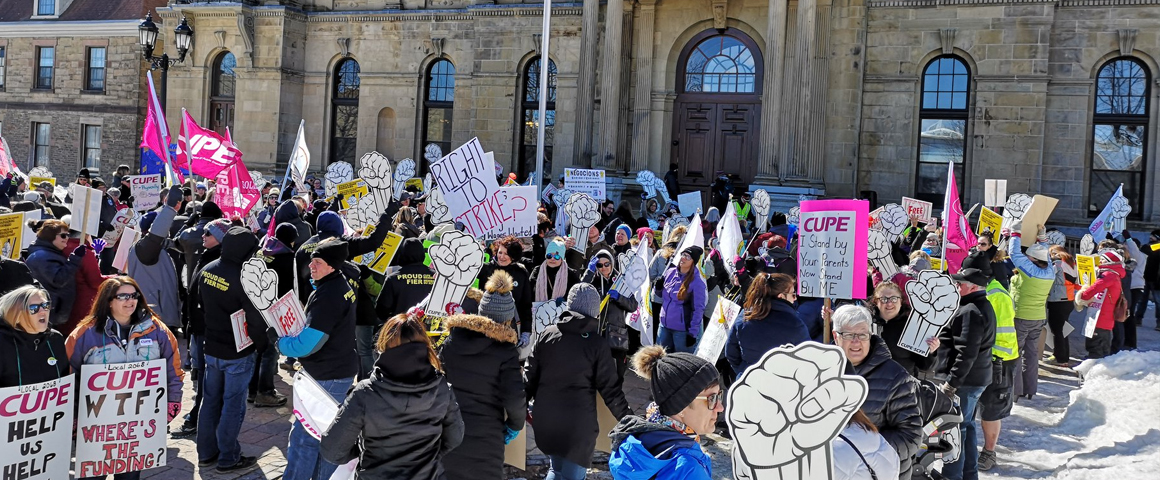Newfoundland and Labrador’s provincial budget was released on March 28 to relatively little fanfare, with Liberal premier Dwight Ball downplaying it as a “steady as she goes” budget. Though not entirely off the mark, Ball’s comment rather disingenuously implies there are still some cuts in the name of “efficiency” but nothing we need to worry about. A better, if less-nautical, analogy would compare this budget to the state of many of the province’s roads: a quick patch job to make it look like something is being done while doing nothing to address the underlying problems.
In the budget speech, finance minister Tom Osborne stated early on that “(the provincial government) cannot take such severe action as massive job reductions and cuts to services”, a nod no doubt to the widespread discontent in the province following the 2016 budget in particular. Public sector workers were able to secure a no-layoff clause in collective bargaining. In return, however, NAPE (Newfoundland Association of Public Employees) members had to accept a four-year wage freeze. Negotiations with the Newfoundland and Labrador Teacher’s Association (NLTA) are ongoing, and the teachers may be asked to accept a wage freeze as well.
Speaking of education, local Memorial University students will still have a tuition freeze this year, the caveat being that the university’s operating grant has been reduced again. The grant’s cut of about $9 million is offset by an increase in support for the province’s tuition freeze. The provincial government loves to remind us that the annual grant is the largest per capital public contribution to a university anywhere in Canada, small comfort for students who will have to pay yet more in additional fees which have been introduced in recent years, and will no doubt increase to reflect the continuing cuts. Students from out of province or foreign countries pay more as it is.
While on the topic of folks from outside the province, the government has paid lip service to immigration at various points, and there is apparently some money in the budget as part of a program to attract immigrants to Newfoundland and Labrador. Immigration to this province is quite small, and many do not stay for long. It is not hard to understand why: they want to make a living. If the provincial government wants more immigrants and to reverse the trend of aging population, there must be a large-scale job creation effort. And those jobs must be able to pay for the cost of living here.
So what are the Ball Liberals focusing their efforts on? Not surprisingly, the oil and gas sector continues to consume their imagination, with Minister Osborne’s speech saying how excited they are about continuing developments in the offshore oil fields, all but saying how grateful we should be for the royalties we get while the multinationals rake in the profits and keep sucking the earth dry. This province could be a leader in renewable energy sources, but apparently the hydro project at Muskrat Falls satisfies that for the government. Outrageously over budget at nearly $13 billion, opposed by indigenous communities in Labrador, of debatable utility to the province, and having major environmental impacts of its own, Muskrat Falls is hardly a poster-child of success.
It is rather shocking that almost nothing is being done about wind power for example. It is frustrating to think about what else could be done with that money. Nalcor, the crown corporation responsible for the province’s energy sector, is furthermore being split. The new division will be strictly for the oil and gas industry, and one cannot but wonder what this will mean for the future relationship between the provincial government and big oil.
Healthcare continues to slip. There is evidently a commitment to shift focus to preventative care, but ultimately the province still suffers from a lack of healthcare space and specialists. Some new facilities will be built in the coming years, but they will largely replace older ones. This includes the Western Memorial Regional Hospital in Corner Brook and the Waterford Hospital in St. John’s, a notorious mental health facility. And the provincial government is openly supporting P3s as the means of getting this infrastructure built. What’s more, Health Minister John Haggie insists that we have enough healthcare workers and that service delivery is mainly a matter of how they are distributed. The nurses’ union is not buying that for a second, fed up as they are with being overstretched. Quite justifiably they say we need more nurses due to the aging population and other poor health trends in the province which aren’t being seriously addressed.
Meanwhile the people of the province must still get by. The minimum wage is a paltry $11.15 and housing costs continue to be high. Affordable housing came up in the budget, but it is nowhere near what it needs to be, while private real estate continues putting up neighbourhoods that many can barely contemplate paying for. There is some support for down payments, but obviously that is only part of the equation in home ownership. The government also claimed this budget was informed by a “gender based analysis” but as the St. John’s Status of Women Council pointed out, the budget fails to do anything substantive there either. There is nothing about addressing the wage gap, and we shouldn’t hold our breaths for public day care anytime soon.
The Ball government has also made some fanfare releasing a report on a fixed link between the island and Labrador, which could cost around $2 billion and take nearly 15 years. Now, it’s a neat idea and could be of great benefit to northern development. Of course it would mean the provincial government getting serious about road improvement in general if they expect heavy traffic from the mainland to opt for the that route over the Nova Scotia ferry. Most worrisome is that P3s figured in that report as the means of getting it built. Again, we should not be surprised.
So the “steady as she goes-patch up-band aid solution” budget is what it is. We’re supposed to be excited about a possible surplus in four or five years, but what kind of vision is this for Newfoundland and Labrador? Business as usual and what the Liberals like to call “good fiscal control” is not serving the needs of working people in this province, who deserve far better.




